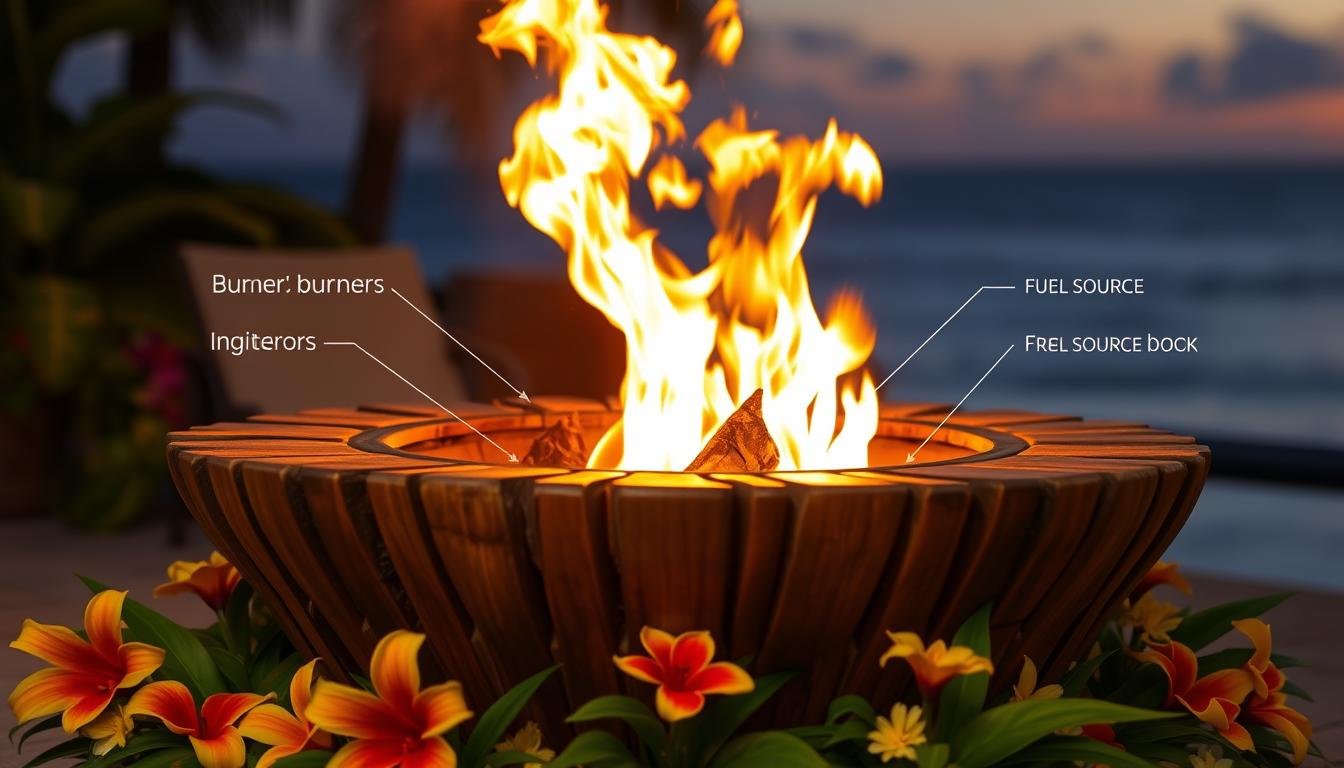Regular maintenance is crucial for extending the lifespan of your outdoor fire pit and ensuring it operates safely. Proper care not only saves you money on potential repairs and replacements but also preserves the aesthetic appeal of your outdoor feature.

This comprehensive guide will walk you through the simple upkeep tips necessary for different types of fire pits. Whether you’re a new fire pit owner or looking to improve your maintenance routine, our advice will help you enjoy your outdoor space for years to come.
By following these easy-to-follow tips, you’ll be able to maintain your fire pit‘s functionality and visual appeal, ensuring it remains a cozy and inviting focal point in your outdoor living area.
Understanding Your Fire Pit Type
Knowing your fire pit’s specific characteristics is key to its upkeep. The maintenance requirements vary significantly depending on whether you have a wood-burning or a gas fire pit.
Wood-Burning Fire Pits
Wood-burning fire pits produce ash, which needs to be removed regularly. The interior surface also requires cleaning to prevent the buildup of creosote and soot. As “A clean fire pit is a safe fire pit,” regular maintenance is crucial.
Gas Fire Pits
Gas fire pits, on the other hand, require maintenance focused on the burner and fuel line. Ensuring these components are clean and functioning properly is essential for safe operation.
Different Materials and Their Needs
The material of your fire pit also affects its maintenance. For instance, steel fire pits need rust prevention, while stone fire pits require protection from freeze-thaw cycles. Understanding these needs helps in maintaining your fire pit’s durability and aesthetic appeal.
Essential Fire Pit Care Instructions
Understanding the basics of fire pit care is essential for ensuring safety and longevity. Proper maintenance involves several key steps that help keep your fire pit in good condition.
What to Burn and What to Avoid
For wood-burning fire pits, it’s crucial to burn only dry, split wood and small sticks. Avoid using accelerants like lighter fluid and household trash, as they can release toxins. Using the right fuel is key to safe and efficient burning.
Certain materials should never be burned in fire pits, including treated wood, household trash, and plastics. These materials can release harmful chemicals when burned.

Proper Extinguishing Techniques
Letting the flames die down naturally is preferable to dousing them with water. Rapid temperature changes can crack the fire pit, so it’s best to wait for the fire to burn out on its own.
Gathering Necessary Cleaning Supplies
To clean your fire pit, gather supplies like gloves, brushes, appropriate cleaning solutions, and heat-resistant containers for ash disposal. Having the right tools makes the cleaning process safer and more efficient.
| Supply | Purpose |
|---|---|
| Gloves | Protect hands from heat and debris |
| Brushes | Remove ash and debris from the fire pit |
| Cleaning Solutions | Clean the fire pit surface |
| Heat-resistant Containers | Dispose of ash safely |
By following these essential care instructions, you can ensure your fire pit remains safe and functional for years to come. Regular maintenance not only enhances safety but also prolongs the lifespan of your fire pit.
Cleaning Different Types of Fire Pits
Different types of fire pits demand distinct cleaning approaches to preserve their durability and aesthetic appeal. The material your fire pit is made of dictates the best cleaning practices to maintain its condition and ensure longevity.
Stone and Masonry Fire Pit Cleaning
For stone and masonry fire pits, a thorough cleaning is essential to remove grime and maintain their appearance. Safety precautions are crucial when using cleaning agents.
Safety Precautions with Cleaning Agents
When cleaning stone or masonry fire pits, it’s essential to use protective gear, including gloves and goggles, especially when working with caustic substances like muriatic acid.
Step-by-Step Cleaning Process
To clean a stone or masonry fire pit, start by removing debris. Then, mix a solution of 10 parts water to 1 part muriatic acid. Apply this solution to the stone surface and scrub with a durable brush. Rinse thoroughly with water and allow the surface to dry completely.
| Material | Cleaning Solution | Tools |
|---|---|---|
| Stone/Masonry | Muriatic Acid Solution (10:1) | Durable Brush |
| Metal (Steel/Copper) | Hot Soapy Water | Soft Cloth |
| Cast Iron | Hot Soapy Water | Steel Wool |
Metal Fire Pit Maintenance
Metal fire pits require regular cleaning to prevent rust and maintain their appearance. The cleaning method varies depending on the type of metal.
Steel and Copper Fire Pit Care
For steel and copper fire pits, use hot soapy water and a soft cloth to clean the surface. Dry immediately to prevent rust.
Cast Iron Fire Pit Cleaning
Cast iron fire pits can be cleaned with hot soapy water and steel wool. Ensure they are dried thoroughly to prevent rust.
Gas Fire Pit Cleaning
Gas fire pits require gentle cleaning around burners and fuel lines to maintain their functionality and appearance.
Burner and Fuel Line Maintenance
Use a soft brush to clean around burners and fuel lines, avoiding harsh chemicals that could damage the components.
Surface Cleaning Tips
For the surface of gas fire pits, use a soft cloth and mild cleaning solution to maintain the finish without damaging sensitive components.
Ash Management and Disposal
Proper ash management is crucial for maintaining your fire pit’s performance and ensuring safety. Effective ash management involves several key steps, from safe removal to proper disposal.
Safe Ash Removal Techniques
It’s essential to wait at least one full day after using your fire pit before collecting ashes to ensure they’re completely cool. Use a metal shovel to carefully scoop out the ashes and debris, preventing acidic particles from causing long-term damage and staining to your fire pit.
Proper Disposal Methods
Once removed, place the ashes in a sealed metal container. The disposal method depends on the type of ash; wood ash can be repurposed, while coal ash should be disposed of with general rubbish.
Creative Uses for Wood Ash
Wood ash can be beneficial for your garden, adding nutrients to the soil and deterring slugs and snails from your plants. It can also be used to enrich your compost.

Preventing Damage and Extending Lifespan
Protecting your fire pit from various elements is key to ensuring it remains a cozy focal point in your outdoor space. Regular maintenance and protective measures can significantly enhance its durability and lifespan.
Rust Prevention for Metal Fire Pits
For metal fire pits, preventing rust is crucial. After cleaning or rain, dry the fire pit thoroughly to prevent moisture buildup. For mild steel fire pits, consider adding a layer of vegetable oil to protect against rust. However, if you have a corten steel fire pit, a protective rust layer will develop over time, which should not be removed.
Weather Protection Strategies
Using covers to protect your fire pit from the elements when not in use is an effective way to prevent damage. Additionally, consider the placement of your fire pit in your outdoor space to minimize exposure to harsh weather conditions.
Seasonal Maintenance Schedule
A regular maintenance schedule is essential for extending the lifespan of your fire pit. Perform a deep cleaning every six months, depending on usage frequency. Here’s a simple seasonal maintenance table to follow:
| Season | Maintenance Task |
|---|---|
| Spring | Inspect for damage, clean, and apply protective coating if necessary |
| Summer | Regularly clean after use, check for rust or damage |
| Fall | Deep clean, prepare for winter storage or use |
| Winter | Cover and protect from elements, perform deep cleaning if used frequently |
By following these guidelines and maintaining your fire pit regularly, you can significantly extend its lifespan and enjoy it for years to come.
Conclusion: Enjoying Your Well-Maintained Fire Pit
Regular upkeep of your fire pit ensures years of safe and enjoyable use. By following the maintenance tips outlined in this guide, you can enhance your outdoor living spaces and create a warm, inviting atmosphere for gatherings.
Proper maintenance involves different cleaning approaches for various fire pit types, whether you have a wood-burning or gas fire pit. Regular care not only improves safety but also extends the lifespan of your equipment.
To keep your fire pit in top condition, remember to let it cool completely before cleaning, and use the right tools for the job. Establishing a regular maintenance schedule that includes ash removal and seasonal protection will allow you to enjoy your fire pit more frequently and worry-free.
By keeping basic maintenance supplies on hand and following these guidelines, your fire pit will become the heart of your outdoor gatherings, creating lasting memories for years to come.

John Carter is a firepit expert with 10+ years of experience in outdoor heating solutions. He specializes in firepit selection, installation, and maintenance, sharing tips on DIY projects, product reviews, and backyard entertainment. Passionate about creating cozy outdoor spaces, he helps homeowners choose the perfect firepit for their needs


